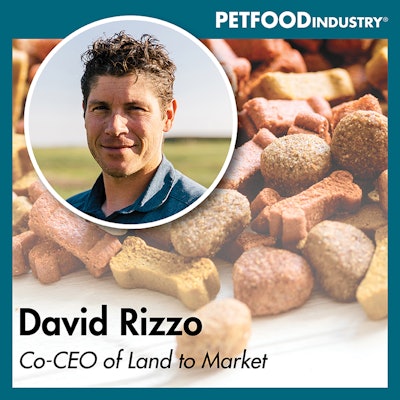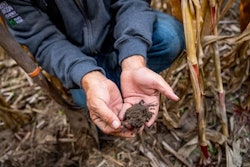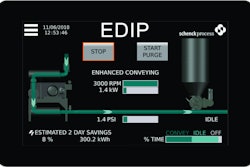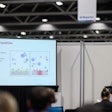
The phrase "regenerative agriculture" has been popping up more and more in industry conversations regarding sustainability, which is why I brought on regenerative agriculture expert and Co-CEO of Land to Market David Rizzo to help me wade through what the pet food industry needs to know about the concept. Whether you're curious, just getting started, or already in the thick of your sustainability journey, there's something in this conversation for you!
The below transcript is from Episode 24 of the Trending: Pet Food podcast, where I spoke with Co-CEO of Land to Market David Rizzo about the concept of regenerative agriculture and where it fits into the pet food industry. You can find the episode at www.PetfoodIndustry.com/trending-pet-food-podcast, on SoundCloud or on your favorite podcast platform. This episode originally aired on December 21, 2022.
Lindsay Beaton – Editor, Petfood Industry magazine and Host, Trending: Pet Food podcast
Hello, and welcome to Trending: Pet Food, the industry podcast where we cover all the latest hot topics and trends in pet food. I'm your host and Editor of Petfood Industry magazine Lindsay Beaton, and I'm here today with Co-CEO of Land To Market David Rizzo. Hi, David, and welcome!
David Rizzo – Co-CEO, Land to Market
Hi, Lindsay, thank you. It's great to be here.
Beaton: In case you're not familiar with David, here's a little bit about him. He holds a bachelor’s degree in Computer Information Systems and an MBA in Marketing, and his career has evolved from IT consulting and small business development to include operations, brand-building and transformative leadership for internationally recognized organizations with sustainable, earth-conscious values. While owning an IT firm that offered innovative ways of improving business processes through applied technology, David was invited by one of his clients, a start-up focused on developing natural and nutritious dog treats, to join the team and help grow the brand beyond infancy. Under his expanded involvement, Zuke's went on to become one of the most recognizable names in the pet care industry. Throughout his career in business and technology, two things have remained at the core of his endeavors: A passion for respecting and protecting the great outdoors, and a commitment to earth-conscious production and net-positive outcomes. These ideals form the foundation of his role as Co-CEO of the Savory Institute's Land to Market program.
Land to Market is the world's first verified sourcing solution for regenerative agriculture and the only outcomes-based verification in the market today. Serving as a consultancy for creating farm-to-finished goods, the team has built a global network of producers with land that has been verified regenerative through ecological outcome verification, a scientific protocol that monitors ecosystem health. They then match these producers with brands that can use their raw materials such as leather, wool, meat and dairy, and place the verified Land to Market seal on products created from these relationships.
David's extensive interest, knowledge and experience in eco-conscious business practices in the pet food industry is why I brought him on to help me answer today's question: What is regenerative agriculture, and what is its place in the pet food industry?
So David, I'm going to start with a bit of a 101 question just to set us up here. What is regenerative agriculture?
Rizzo: I think you could probably define it in many different ways. And if you do your research on the internet, there are a lot of different organizations that are playing in this same space that might say it slightly differently than my own perception, or how Land to Market really looks at it. But the key thread through all of those is really that regenerative agriculture is a system of managing agricultural production bases in a way that creates positive outcomes in soil health, ecosystem function, biodiversity and many other attributes related to the ecosystem processes.
Beaton: And how does something like that play into larger global sustainability trends? Because this feels like a next step in the sustainability conversation. Or is it a branch off a path that people are starting to take as they're discussing more about sustainability?
Rizzo: It's an evolution. From my perspective, sustainability came to life when we realized a lot of what we do in agriculture, what we do in our value chains, what we do in our products, have a negative impact, depending on how we manage and make decisions around creating what comes from all of these different parts of the value chain. The idea was, if we're extracting or if we're degrading, or if we're doing something that has a negative impact, how do we reverse that or mitigate that? And sustainability, you know, of course, came about to say, "Well, let's not create any of that negative impact with what we do." And so it was a great first stage from going from possibly doing bad things and not figuring out how to prevent that to then saying, "Let's make sure we pay attention to not doing as many bad things and at least be doing nothing bad, if possible." So the idea of sustainable is, let's do less bad, let's make sure we're not doing as much bad as possible with what we're doing. And regenerative is taking it a step ahead and saying, let's look at it through the lens of how do we do it and improve things in the process.
Beaton: Was regenerative agriculture already happening in some places, just without a name? Were these practices that were already going on? Or is this a brand-new thing that you've had to implement as you talk to farmers and talk to those who are at the start or at the heart of regenerative agriculture?
Rizzo: No, I think the term regenerative agriculture is something that's been coined in the recent years in terms of management practices of agricultural systems, but there [have always] been people managing agricultural systems in a way that is producing positive outcomes. Whether they were coined regenerative then, or whether they are just really managing through a holistic lens of all the things that are impacted by decisions and agricultural systems, might be different depending on where you go across the globe. But yes, there's definitely been people who have been managing in what would be considered a regenerative way for decades.
Some people have chosen that decisions around ecosystem health are just as important as their social decisions as well as their financial decisions. And they're looking at it as a whole view of this, versus being forced into an industrialized complex of how agriculture is seen in most cases, especially here in North America. That was a big part of how Land to Market was born. Our parent organization, the Savory Institute, has been training farmers and ranchers across the globe for decades on how to manage their land more holistically through holistic management. And these management frameworks and practices that emerged from that training create net positive outcomes or regenerative agricultural systems. And so brands started to approach us saying, you know, all these farmers are doing all these great things on the ground, how do we get connected to them to source raw materials and make products. Land to Market was kind of born out of that desire to connect the market to these producers that are producing products in a better way than our standard industrialized system.
Beaton: And when did pet food become part of the conversation?
Rizzo: A lot of our focus is spent in animal-based grazing systems, ruminant grazing systems. And so it was really an easy entry point into Pet, knowing how much animal protein is used in the pet industry. I at Zuke's was the driver of getting into this regenerative agricultural space in the pet industry back in 2016, 2017, when I was engaging with the Savory Institute and Land to Market was coming to life. So it was really about five years ago, from my perspective, as I was on the brand side of Zuke's, that I was looking for a new way to source raw materials that was better than sustainable. Making that engagement relationship happen with Pet was kind of the first stage of like, we should be looking through the same lens as you might be looking at it on the food side, or on apparel, fashion, other materials that come from ruminant grazing systems.
Beaton: I want to talk about challenges a little bit, because obviously there's a lot going on right now: Supply chain issues, the clash between wanting to have sustainable or eco-conscious business practices versus the cost of some of those practices right now, and how cost-conscious consumers are being while at the same time still being willing to pay for their pets' food and their pets' treats and things like that. And there are just a lot of complex things happening right now in terms of the economics of the pet food industry. So what are some of the challenges right now in implementing regenerative agriculture practices into the pet food supply chain? Is it an individual conversation you're having with each individual supplier? Or is there more of an overarching message that needs to get out to everybody that suits everyone? How does that work? And how do those conversations work for you right now?
Rizzo: There are a couple aspects I want to pick apart there in that question, because there's a lot. Us as consumers, I didn't know this until I learned my way into being in this environment to Land to Market and working in the space that we do, and building value chains from the farm all the way to the consumer, is let's start with that price piece that you brought to the conversation. There's always some barrier at the consumer level of what price they're willing to pay for a product based off their own values, the quality of the product, composition of the product, etc. The most interesting part I found in Pet is it just seems like there's a lot more consideration for paying for a better product at a higher price than you'd see even in food. It's almost like those consumers in Pet are going to go buy a better product for their pet than they'd buy for themselves sometimes.
And it surprises me time and time again, a lot of that is driven off of how many points in the supply chain are involved in creating that final product. And in Pet we found, you know, there's a lot of different steps along the way depending on how you build your products and how well you know your value chain. That is where the complexity comes in. And how we engage is, today's supply chains were built upon efficiency, profitability, cost effectiveness, etc. But they weren't really built on resiliency. So there's a lot of issue around disruptions in those supply chains create disruptions at the consumer level, at the retail level, and also create disruption at the financial investor level when you talk about those brands that are working with a financial institution or investors to build their brand and build their products, that when supply chains break down, there's also a breakdown that people don't recognize and relationships at those spaces as well.
And so resiliency becomes a key aspect of, how do you take that into your mindset of building relationships throughout that value chain in a way that if something breaks down in what is typical linear supply chain, how do you fix that, versus if you start to look at supply chains more like webs and actually look at the idea of: How do you build resiliency that if part of that web were to break, there's other parts of our web that are still connected that keep that supply chain flowing, essentially. At Land to Market, we really started working with the farmers first, then we started working with the brands to say, how do we pull these two together? How far back does the brand see in their value chain or supply chain? And how far forward can we see from the farm? And then how do we close those gaps? How do we connect the two if the gap doesn't need to exist, it's just not another person that's needed that we can actually solve that and close a shorter supply chain, essentially. And so we engage with everybody through that value chain that's already involved and we identify: How do we create resiliency, if anybody was to not exist in that value chain, and it's really just adding that web effect, what's going on for the in-brand that's making the product for the consumer as well as the farmers on the other end, because ultimately, the farmer and the consumer are so disconnected in terms of what really is happening, the consumer sees what the brand tells them. And it's really what they want to know, is the relationship between the farm and the consumer, is a very important story to tell.
Beaton: I want to dive into that a little more, because that is 100% true, and I think a significant complication in terms of people knowing where their food comes from, or their pets' food in this case, and what supply chain means, where ingredients come from, how it all gets put together, we as a society have become very disconnected from the process. We're just so used to seeing the end product. And the middleman is essentially the brand. Anybody who listens to this podcast knows that I'm a huge proponent for education and I love a good education question. So I want to hear what kind of educating you're doing to help bridge those gaps, because they're there and it makes anything having to do with agriculture, anything having to do with human food, pet food, with regard to the end consumer very complicated, because they just don't know. But we're also at a time when I feel like people are trying to reconnect in their own way. And so I can see something like what you're doing when you're trying to build a web being a significant step in the right direction. So what onus do you feel to make that web as strong as possible? And where are the educational pain points right now? Is it more on the farmer side? Is it on the brand side? Is on the consumer side?
Rizzo: The challenges are the idea that change is hard, one. A lot of these systems, for them to be part of a resilient web, are going to have to change in some way. What's hard to see is that change is probably going to create a more positive situation for them in the future, which is part of that resiliency. And the change barrier is what creates the complexity of, like, how do we get that message out in a way that change is not even thought of, it's “this is what I want to do.” It becomes a values-aligned approach, instead of being a, here's a prescription, this is the way I'm supposed to do it, because that's what everybody else is doing [approach]. Consumers are still learning that the awareness of regenerative agriculture and the size of consumer base that is looking for these kinds of products is growing immensely. But it's still not sure what regenerative agriculture is and what that means. And there's a lot of people out there defining it differently, like I said earlier, and so it creates confusion as well.
The reason we chose the path that we did with an outcome-based verification is, let's not tell you what we think is right to do to create regenerative outcomes or net positive outcomes. Let's just go measure it with empirical science and let the data show you what is actually going on in the land. The pet industry, there's been a number of brands, I think, that have emerged in terms of wanting to identify the farm, wanting to make that connection that, hey, we know the farm this raw material and this product we're selling you came from. That doesn't mean that farm's doing something good for the environment in the way that they manage their land. So we wanted to add an element of, how do we bring the voice of the land into the product and into the marketplace? That comes with all of its complexities because most consumers, the majority, the large mass consumer set is going to really be looking for those lower-priced products. They're not necessarily as much connected to environmental impact as they would be connected to cost. But I think that's the challenge and the barrier we need to break through, is that more and more people are going to, from a values perspective, want to know more about the environment as the climate crisis (as we sometimes say or hear) becomes more and more evident, impacts people more and more.
Beaton: You talked about using empirical evidence and empirical data to figure out what will be the best in terms of establishing a regenerative agriculture practice. Are you finding that there are similarities among everything that people need to be doing, or is it very specific depending on the land you're working with and the farmers you're working with? How customized is this whole process of figuring out regenerative agriculture for each farmer that you're working with?
Rizzo: That's a big one that could be impacted and argued and debated across many different people's beliefs. But ultimately, regenerative practice is something we try to not put in our mentality, because it's actually about management. And management can be applied in context of that land base and that land manager, based off of wanting to improve their systems as a whole. Practices typically are prescriptive, you know, you think about the programs out there, they're practice-based. It's like, here's all the things that you should be doing, because we have seen them create really great results here. But what you do in a brittle environment, like California, or Nevada, versus what you do in the southeast in Georgia, are completely different environments as a whole. And that doesn't mean that those practices apply and create the same results when replicated in different ecosystem environments, [e.g.] a very wet, warm location year-round versus a very dry version.
So it's very much, we believe, the decisions should be made within the context of that eco-region that they're located in. And it's about understanding how to read the health of that ecosystem, have the feedback loops that you can see that help you make the right management decisions so that's continually improved. And that's the struggle, I think, you know, when organic was born, 30 years ago, 40 years ago, whatever it was, I think it wanted to really bring that mentality that if we're not using all these inputs, and all of these chemicals, we have the ability to create better functioning systems. But what they didn't realize is that in a practice-based system, that being applied exactly the same wherever you go is not going to get you the intended consequences or intended outcomes everywhere you go. And so ultimately, what it did is it just pigeon-holed that program, which I think personally has lots of positives, still that are applicable and good to the consumer. But it put it into this place where it's like, we can call this organic, but we can't say it's creating positive outcomes in the environment.
Beaton: Speaking of outcomes, I want to talk about benefits. Let's say there is a pet food company or an ingredient supplier, or somebody listening to this podcast right now, and maybe they've started looking into regenerative agriculture. Maybe they're on a sustainability journey. And they haven't even thought about that next step yet, but now they're intrigued. What are some of the short-term benefits — and we're going to get into long-term benefits in a minute — but what are some of the short-term benefits that might help jumpstart somebody's decision to look into this more as a potential business strategy or a solution for something that they're trying to put together in terms of being more eco-conscious along their supply chain?
Rizzo: Short-term benefits, in this case, I think have to be focused on the organization's own values. It has to be about, I am following the journey on the values that I want to exude or I want to embody. And in order for me to do that, these are the kinds of changes that I need to make and I'm willing to make. You know, they come naturally because it's that values alignment aspect that's part of what helps drive that culture of an organization; it's a part of all those things that are very important to say, we need to change the way we do business. And it's not just driven off of dollars and profits, it's driven off of a broader, more holistic view of all the values that are important to that organization. And in short-term a shift to systems like this are aligned with a larger value set that, you know, is emerging globally in this space.
Beaton: So it sounds like the immediate payoff, a lot of it is internally focused, just giving your company culture a center to work around, a goal, saying this is what we're committing to, this is what we are prepared to give our customers, this is the change we need to make, and we're making it right now.
Rizzo: Absolutely not to take any other program's words, but it's just something that I resonate with: Using business as a force for good, like B Corp certification, has always said the idea is that making these kinds of decisions to start integrating these types of management decisions and sourcing decisions and organizational decisions is changing the way we do business, and using their organization as a force for good. And it's, why would we ask the farmers to change their management, to do more good, create more positive outcomes, and not do that at the organizational level too?
Beaton: What about the long-term benefits? What are you seeing as companies implement this into their supply chain and make it a priority, and as things continue to flow and the idea of regenerative agriculture expands, what are some of the benefits we're seeing?
Rizzo: I guess you could go down many pathways in this instance. The resiliency is the first thing that comes to mind because I've said that word multiple times already. And that's maybe on the business side, we call it business, continuity, all of those things are important to the long-term viability of the business is having the right systems built in that allow that business to continue forward and not have any significant challenges that could prevent the business from moving forward. Because I think that's one key aspect, short-term and long-term, that you're in that process of building those systems out. There's a lot around, when does it create long-term financial resilience as well, you know, because up-front change usually feels like it costs more.
But what does the long-term look like over time? I think that a major long-term aspect of that that gets missed sometimes in the thinking process is that it's not necessarily about profitability. Up front, it's about market share. And if you show profitability, people get too stuck in the short-term around those items. We've seen it with organic and other products that, as we get to scale for supply products, premium value and cost typically start to align more with commodity pricing. That is an issue in itself, because we're not really wanting to think about it through the lens of what we call commodities today, because we want regenerative agricultural production to be just the norm. And it's not. We have commodity style, conventional, and then we have regenerative and we have organic. We want all of it to shift to this mindset of, we need to have all these systems pushing to a net positive outcome approach. Does that mean a system has to die? Does that mean the system has to change? Most likely, but that's a part of that long-term visibility, to think through the whole picture and not just be looking at specific attributes that are important, what typical business would say today.
Beaton: I think that's an important thing to point out as well, because all of this discussion around sustainability and eco-consciousness and trying to find a better way to do things overall, and consumers being more aware and wanting more information, has all really ramped up at the same time that there is a lot going on in the world. And there are other really practical challenges when it comes to creating consumer goods right now. So it can be very easy right now to stay in emergency mode and just think about the short-term. And we have to balance the economics right now and the realities of right now. How can we put together these long-term strategies when three years ago, we had a solid long-term strategy, and then everybody's long-term strategies blew up in their face, right? I think it's important to be realistic about the fact that change does cost money and it is an investment. And sometimes there's a bit of patience involved in figuring out what your long-term strategy is, and seeing that payoff and understanding what some of the other payoffs are in the short-term, so that you can hang in there and establish things to get to the long-term. Does that seem fair?
Rizzo: That seems absolutely fair. Let's think about the long-term environmental benefits, the concerns around climate change, etc. What happens in 30 to 60 years if we can't produce those raw materials anymore because we made more decisions around profitability than around environmental impact? And so looking at our output, being able to bring the lens back here to the now is highly important, and it's going to depend business to business. Some businesses just aren't going to do it. That's just not the way they operate. That's not their values, their value's to generate money, you know, whether it's for internal owners or external stakeholders or publicly owned stakeholders, it's still typically financially driven. And that's probably the biggest change at this point in time is, how do you actually look at it as an investment, as you said, that actually generates a different kind of value, because — call it valuation, I guess — that my decision to really invest in improving environmental impact through my raw material sourcing, as well as everything else, I can mitigate the supply chain, while I still have to either cut my margins or sell a higher-price product that's going to move slower. It's the right thing for me to do as a business because it creates a more resilient future. To me, it's a no brainer, but I also understand different beliefs and other lenses as to why they might not do that.
Beaton: So we've talked about the short-term and we've talked about the long-term. Let's talk about, I suppose, the medium-term. What role do you see regenerative agriculture playing in the next, say, five to 10 years in the pet food industry? When do you see it really taking hold and digging in if it hasn't done that already? And how do you see it evolving? Or what do you hope for it to do?
Rizzo: I would love to have seen it taking a stronger hold already in the pet industry. I think the way, or at least the way I perceive the pet industry evolves in terms of, like, what is that next new thing and what's the next way of something to be promoted or marketed? We always say it's commonly follow the human food trend space — what I would have loved to see is the pet industry actually not hesitate to move faster, and to regenerative agriculture rather than wait on the human food industry. Medium-term, for me, would be that the pet industry becomes a leader in this space, especially knowing just alone in the amount of meat consumption how much is consumed, let's not even talk about when we get into the plant-based, grain-based production systems that are a whole other conversation in terms of the current industrialized structures. They're highly degrading and have a long way to go to figure out how they're going to do it in a regenerative way. Medium-term would be an adoption across the industry that, let's start doing as much good with the raw materials that are the furthest along at more scale. I would love it if it was a situation where buying products that didn't come from regenerative-verified systems had a negative impact — financially, grading, whatever it be, you can choose to still do this but there's a penalty to doing it that way. And I don't know that that's something we'll ever achieve, but it's something that is ideal. The pet industry has the ability to accelerate this movement just as fast if not faster than the human food industry, in my opinion.
Beaton: That's a very interesting outlook, because the pet food industry is so used to following the human food industry that it's interesting to think of the idea of pet food leading the way and influencing the human food industry the way the human food industry has long influenced the pet food industry.
Rizzo: There's another aspect of that, too, that's important. Not only in the human food industry, we see more consumption of human-grade ingredients, you know, desire for brands and consumers on the Pet side of things. We all know that there's a future state of the growth of human population and a lack of food to feed the world. Is it the right thing to be feeding human-grade ingredients to our pets versus coming together across industries to consume the whole animal that comes from the regenerative systems that are producing positive environmental outcomes? And what I think we'll also see in future stated more nutrient-dense products.
Beaton: Before we wrap up, I want to discuss a little bit about what regenerative agriculture could evolve into in terms of other trends in the pet food industry. So obviously, sustainability is a huge one, things like transparency when it comes to sourcing is another really big one, and just a true desire that consumers have to know more about every avenue of the supply chain from farm to pet food bowl, basically. Are there any opportunities with regenerative agriculture to play into some of those other trends or even enhance them in the future?
Rizzo: Yes, absolutely. I think that's the unique and special thing about not getting pigeon-holed to the idea that regenerative agriculture is just this different way of doing agriculture. Regenerative agriculture done well should have a lot of inherent things that emerged from it as well. And when you talk about transparency, and you talk about traceability, or animal welfare, nutrient density, all these things that are important to that product, as well, and that consumer that's buying those products. Regenerative agriculture is really starting at the base on the farm, that if you're doing it well, all those things emerge. And so does it take a lot of these systems that are talked about in the pet industry today, from what is really a kind of a low-resolution trust approach to a higher resolution of information available to that consumer.
I buy this product that's coming from this farm in Tennessee. And I now know they're creating filters based off the data that is coming from their ecosystem monitoring. I know that to create net positive results in that kind of ecosystem they have to manage their animals in a way that would mimic nature, which means that they're living a much more standard animal welfare approach than being crammed into a house or crammed into a feedlot. Does that mean that the people in that community because their thriving land is helping their community thrive as well? Most likely. Can that be shown through the data that we've collected through a different way? Can that raw material be measured in a way that shows that that healthier soil and that healthier functioning ecosystem created a more nutrient-dense product? Absolutely. As well, all of these datasets are emerging in this regenerative agricultural movement, and they're all being pulled together to create what I think will be a higher-resolution future around transparency of what we're really doing here and what's really happening.
Beaton: Well, I want to thank you very much for coming on today, David. I've been hearing the phrase "regenerative agriculture" more and more as I talk to people around the industry, so I thought it was important to have you on to help me start really figuring out where it might fit in the sustainability and the eco-conscious business plans of so many pet food companies who are trying to take these next steps. Before we go, let's do a little plug. Where can people find you and where can people learn more about Land to Market?
Rizzo: You can definitely find me on LinkedIn, David Rizzo, and obviously Land to Market, but you can also find a more comprehensive amount of information surrounding myself and Land to Market at www.landtomarket.com.
Beaton: Excellent. That is it for this episode of Trending: Pet Food. You can find us on www.PetfoodIndustry.com, SoundCloud or your favorite podcast platform. You can also follow us on Instagram @trendingpetfoodpodcast. And if you want to chat or have any feedback, I'd love to hear from you! Feel free to drop me an email at [email protected]. Once again, I'm Lindsay Beaton, your host and editor of Petfood Industry magazine, and we'll talk to you next time. Thanks for tuning in!
















